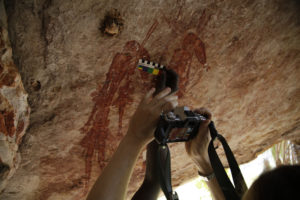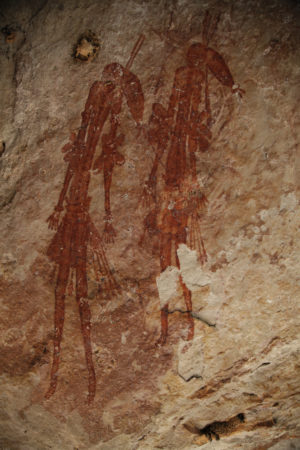
Science Advances—By using a relatively rare approach to date pre-historic rock paintings in Western Australia – involving dating the remnants of mud wasp nests found over and under the art – scientists found the artwork to be much younger than previously suspected. The study is one of few in recent decades to attempt the challenge of dating of wasp nest materials in order to determine the age of prehistoric art. To date, evidence has indicated the Gwion paintings of the Kimberly region of Australia were painted as far back as 17,000 years ago (17kya) and over the span of several thousand years, suggesting a remarkably long-lived artistic tradition. This body of artwork, however, has been notoriously hard to date. Now, Damien Finch and colleagues present evidence suggesting the Gwion motifs were painted during a narrow timeframe, about 12,400 years ago. To do this, they used radiocarbon dating, a technique to determine how long ago living material died. Working with the traditional owners of the aboriginal sites, they analyzed the nests of wasps that build mud nests on rock walls, sometimes incorporating charcoal from regular local brushfires. By dating the charcoal in the nests, researchers estimated when the nests were built. By dating nests that were painted over, they determined the maximum age of the artwork. By dating nests on top of paintings, they found minimum ages. The possible age ranges of 19 of the 21 paintings studied overlap during a brief period between 12 and 13 kya. Two samples fall outside of that range. One, which was found under a painting but dated at only 6,900 years old, is thought to be unreliable and possibly contaminated. However, the second was found over a painting and more reliably estimated to be 16,600 years old, complicating the findings. The authors call for further mud nest samples to be responsibly identified and dated.
_____________________________

Researchers record details of mud wasp nest overlying one of a pair of Gwion rock art motifs prior to removal of the nest for radiocarbon dating. Mark Jones
_____________________________

Two classic Gwion human figures with headdresses and arm and waist decorations. Mark Jones
_____________________________
Article source: Science Advances news release
*“12,000-Year-old aboriginal rock art from the Kimberley region, Western Australia,” by D. Finch; A. Gleadow; J. Hergt; H. Green at University of Melbourne in Melbourne, VIC, Australia; V.A. Levchenko at Australian Nuclear Science and Technology Organisation in Sydney, VIC, Australia; P. Heaney at Lettuce Create in Strathpine, QLD, Australia; P. Veth; S. Harper; S. Ouzman at University of Western Australia in Crawley, WA, Australia; C. Myers at Dunkeld Pastoral Co. Pty Ltd. Theda Station in Kununurra, WA, Australia.
__________________________
Advertisement





